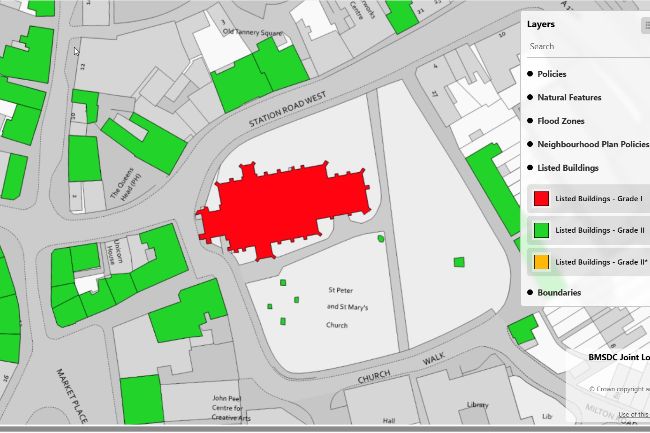
Improving Data Quality and Confidence in Policies Map Delivery

- Company: Blue Fox Technology Ltd
- Client: Babergh & Mid Suffolk Council
- Year: 2019 - 2025
- Region: England
- Product: OpusMap
- Community engagement
- Geographical information systems (GIS) and mapping
- Plan-making, planning application and data management systems
Introduction
Challenges
The OpusMap support team quickly diagnosed the issue: the map’s layer filters were referencing an empty database field in the Listed Buildings dataset. The incorrect column reference caused the three grade-specific layers (Grade I, II, and II*) to fail when loading in the map viewer. Further inspection revealed deeper inconsistencies in the original GIS file, including:
- Mixed or inconsistent grading conventions
- Missing attribute data
- Incomplete spatial coverage across the BMSDC geographic area
Solutions
- Corrected the layer filter logic in OpusMap to ensure all Listed Building layers rendered as intended
- Cleaned and standardised the original GIS dataset using consistent grading symbology (i.e. I, II, II*)
- Updated attributes to display building names and grades consistently in map search results
- Embedded direct links to Historic England listings for each building to enhance the user experience
- Improved map performance with optimised layer visibility and accessibility rules for complex map areas with multiple map layers
- Uploaded the cleaned dataset and reconfigured the live Policies Map in OpusMap accordingly
Results
The case study highlights what sets OpusMap apart: it’s not just a platform - it’s a partnership. From onboarding to issue resolution, OpusMap empowers planning teams to take control of their spatial data, even in complex or resource-constrained environments. For BMSDC, OpusMap enabled the Planning Policy team to respond quickly and deliver a more accessible and trustworthy Policies Map - without relying on overstretched corporate GIS teams.
By investing in OpusMap, local planning authorities gain more than an interactive mapping tool - they gain a reliable, responsive solution, strengthening data governance, streamlining plan-making processes, and improving public engagement. OpusMap gives you the tools and confidence to publish with precision.
“Thanks again for all your help - it’s really appreciated. The customer has confirmed the changes and we’re following up on your suggestion for future improvements.”
